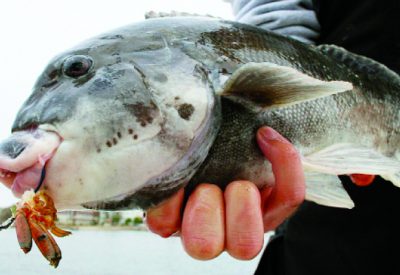by Dr. Julie Ball IGFA Representative,Virginia Beach
Although the weather can be an aggravation this time of year, anglers are hopeful for smooth sailing into the New Year.
Rockfish are always on angler’s minds as the winter season approaches. But it’s hard to say how the rockfish bite will ultimately evolve this year as the schools of really big fish filter into the lower Chesapeake Bay. So far, the pattern is reminiscent of last winter’s trend for these hefty fish, stalling several miles short of their more accessible haunts along the Eastern Shore. For those willing to make the run to wherever the striped bass may migrate in the bay, the results can be rewarding, with many of these fish weighing in excess of 50-pounds. The best method for targeting these larger rockfish is with live eels while drifting or slow-trolling.
Tautog will continue to hit on most lower Chesapeake Bay wrecks and along the structure of the Chesapeake Bay Bridge-Tunnel through December, with the average size tog ranging around 3 to 6-pounds. Nice tautog will also begin to respond on more coastal and offshore wrecks as the waters continue to cool. Boats will also take advantage of the seabass action on these same deeper structures before the season closes at the end of the year. The current regulations allow you to keep 15 seabass per person stretching to at least 12.5-inches. Flounder, trigger fish, and chopper bluefish are also a possibility on many of these same wrecks. This is also the time of year folks are on the lookout for schools bluefin tuna, which can show up most anywhere from a few yards off of the beach, out to the Triangle Wreck area.
The local speckled trout bite has been commendable this season, with the average speck size pushing to around 22-inches, with several gator-sized fish stretching from 27 to 30-inches already making a surprisingly good showing. Most any backwater protected area will offer respectable fish, with Lynnhaven, Rudee, and Little Creek Inlets leading the way. Using a slower retrieve with lures or plastics is more effective for enticing strikes in the colder water. The Elizabeth River is also producing trout, but the size and numbers are unpredictable as the fishery continues to recover. Some nice puppy drum can offer some variety from these same areas.
When anglers find a break in the weather, boats will head for the edge of the Norfolk Canyon where good hauls of big blueline tilefish and grouper are available. Chopper bluefish and jumbo seabass are also a by-catch in these same deep areas, but dog fish will soon begin to overshadow most fishing efforts for deep droppers as the water temperatures drop.
For more information, go to www.drjball.com
